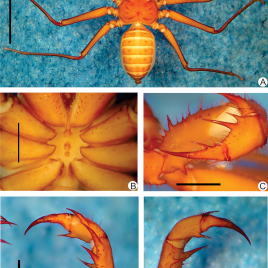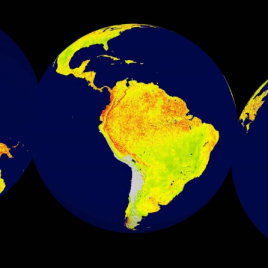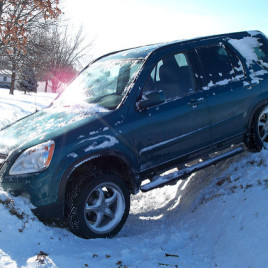An editorial is calling for public health to play a larger role in the Missing and Murdered Indigenous women inquiry (MMIW). Dr. Kirsten Patrick, a deputy editor at the Canadian Medical Association Journal believes many factors underlying the interpersonal violence plaguing Aboriginal women and girls are linked to mental health issues, substance abuse, and other […]
Category: Paper of Interest
Changing grasslands in North America
The productivity of grasslands in North America will increase in future climate scenarios, despite higher temperatures and increased drought, say researchers. They developed this forecast using a new model of the region’s hydrology and vegetation, incorporating data and images gathered from a network of cameras. The model showed an earlier start to the growing […]
Cutting away at the mystery of leafcutting bees
Leafcutting bees use pieces of various plant leaves to build their nests, however determining which plants they prefer has been a challenge. In the past, researchers had to either observe leafcutting bees visiting a plant or identify pieces of leaf in the nest in to know which plant the bees relied on. Now, using DNA […]
Urgent action needed against mycotoxin contamination
The International Association for Research on Cancer is urging action against widespread mycotoxin contamination in developing countries. More than 500 million people are being exposed to fungal toxins, which can cause illness and even death. Dr. David Miller, from Carleton University, is the chair of the working group. Original research published by the International Agency for Research on […]

Breast-feeding after one year and Vitamin D
Breastfeeding children after their first birthday does not provide adequate levels of vitamin D, even if the child is also eating solid foods, according to researchers. They recommend these children should take a vitamin D supplement to prevent health problems, such as rickets. Currently the Canadian Paediatric Society recommends children take vitamin D supplements […]

When snails fly
A snail that flies may sound like science-fiction, but it’s not – quite. The Limacina helicina, a zooplanktonic sea butterfly, is a type of sea snail (the “butterfly” is a misnomer) that moves through the water in the same way a fruit fly flies, by moving its wings in a figure eight pattern. Using […]

Newly discovered and already at risk
Eight new species of the Whip spider have been found in the Brazilian amazon, underscoring how little is known about biodiversity in this rainforest. However half of the newly discovered species’ habitat is threatened by human activity from dams and mining. Original research paper published in PLOS ONE on February 17, 2015. Names and affiliations of selected authors […]

Mapping ecological sensitivity around the world
The areas of the world most sensitive to climate variation have been mapped by researchers. Using 14 years of satellite data researchers were able to develop the vegetation sensitivity index. The index is based on three variables that drive vegetation production – air temperature, water availability, and the degree of cloud cover. The researchers believe […]
When humans and Neanderthals met
Ancestors of modern humans and neanderthals may have interbred 100,000 years ago, earlier than previously thought, according to new genetic analysis. Additionally the gene-flow may have been two way, with each population breeding and receiving genes from the other. Researchers analysed the genomes of a Neanderthal (from the Altai mountains in Central Asia) and a […]

Winter driving must become safer
An editorial from the Canadian Medical Association Journal calls for improving winter road maintenance and safety to decrease the number of deaths due to winter driving in Canada. The authors recommend: Improving road maintenance standards, and tailoring maintenance to local conditions. Government oversight of road service companies to ensure adherence to regulations. Legislation requiring […]
How infants account for dominance
Group size matters when determining who is dominant, at least according to human infants. The team believes this shows infants as young as six months of age are able to assess social dominance by looking at the numerical size of competing groups, an ancient evolutionary ability. Researchers found infants evaluate which group is dominant by […]
NSERC Award Winners
Natural Sciences and Engineering Research Council of Canada The winners of the 2016 NSERC prizes celebrating exceptional research in Canada were announced yesterday they include: Dr. Victoria M. Kaspi, McGill University, is the winner of the Gerhard Herzberg Canada Gold Medal for Science and Engineering. Kapsi studies neutron stars and her research sheds light […]

Printing living bones may be possible
Printing bones and cartilage could be the way of the future. Using specialized ‘bioprinters’, researchers have been able to “print” cells into layered patterns reconstructing human body parts. Current 3D printers are unable to create bone and cartilage with enough structural stability. By combining bioprinters with biodegradable polymer materials researchers were able to “create” the […]
Something’s fishy about childhood obesity
Eating fish more than three times a week during pregnancy is associated with an increased risk of childhood obesity, according to the results of a new study. Women who ate fish more than three times per week were more likely to give birth to children with higher BMI values at ages two, four, and six. […]
Losing money to lose weight
Paying employees to exercise doesn’t work, but taking money away might, according to a new study. Removing a small amount from a cash reward given upfront was more effective at promoting daily physical exercise than receiving a small reward for meeting physical activity goals. Participants in a 13-week physical activity program were given a goal […]
Visualizing the blood-brain barrier
Using a microscope to see inside living tissue, researchers have found how the parasite Toxoplasma gondii passes through the blood brain barrier to invade the central nervous system. The researchers hope this finding will help develop effective strategies to stop the parasite from entering and damaging the brain. T. gondii infects about 30 per cent of […]